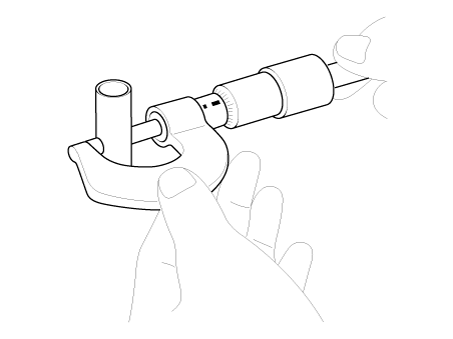Kia Picanto: Cylinder Block Assembly / Piston and Connecting Rod
Kia Picanto JA 2017-2025 Service & Repair Manual / Engine Mechanical System / Cylinder Block Assembly / Piston and Connecting Rod
Repair procedures
| Disassembly |
|
|
| 1. | Remove the engine and transaxle assembly.
(Refer to Engine and Transaxle Assembly - "Engine And Transaxle Assembly")
|
| 2. | Remove the transaxle assembly from the engine assembly.
(Refer to Manual Transaxle System - "Manual Transaxle")
|
| 3. | Remove the flywheel.
(Refer to Cylinder Block Assembly - "Flywheel")
|
| 4. | Remove the rear oil seal.
(Refer to Cylinder Block Assembly - "Rear Oil Seal")
|
| 5. | Install the engine assembly to engine stand for disassembly. |
| 6. | Remove the cylinder head cover.
(Refer to Cylinder Head Assembly - “Cylinder Head Cover”)
|
| 7. | Remove the thermostat housing.
(Refer to Cooling System - “Thermostat”)
|
| 8. | Remove the timing chain.
(Refer to Timing System - “Timing Chain”)
|
| 9. | Remove the intake manifold.
(Refer to Intake and Exhaust System - "Intake Manifold")
|
| 10. | Remove the turbo manifold module.
(Refer to Intake and Exhaust System - "Turbo Manifold Module")
|
| 11. | Remove the cylinder head.
(Refer to Cylinder Head Assembly - “Cylinder Head”)
|
| 12. | Remove the oil pan and the oil screen.
(Refer to Lubrication System - “Oil pan”)
|
| 13. | Remove the ladder frame.
(Refer to Cylinder Block - “Cylinder Block”)
|
| 14. | Check the connecting rod side clearance. |
| 15. | Check the connecting rod bearing cap oil clearance. |
| 16. | Remove the piston and connecting rod assemblies.
|
| 17. | Check for fit between piston and piston pin. Try to move the piston back and forth on the piston pin. If any movement is felt, replace the piston and pin as a set. |
| 18. | Disassemble the piston rings.
|
| 19. | Disassemble the connecting rod from the piston.
|
| Inspection |
Connecting Rod
| 1. | Check the connecting rod end play. Using a feeler gauge, measure the end play while moving the connecting rod back and forth.
|
| 2. | Check the connecting rod bearing oil clearance.
| |||||||||||||||||||||||||||||||||||||||||||||||||||||||||||||||||||||||||||||||||||||||||||||||||||||||||||||
Piston
| 1. | Clean piston
|
| 2. | Check
the piston-to-cylinder clearance by calculating the difference between
the cylinder bore inner diameter and the piston outer diameter.
|
| 3. | Select the piston matching with cylinder bore class.
|
Piston Rings
| 1. | Inspect the piston ring side clearance. Using a feeler gauge, measure the clearance between new piston ring and the wall of the ring groove.
If the clearance is greater than maximum, replace the piston. |
| 2. | Inspect piston ring end gap. To
measure the piston ring end gap, insert a piston ring into the cylinder
bore. Position the ring at right angles to the cylinder wall by gently
pressing it down with a piston. Measure the gap with a feeler gauge. If
the gap exceeds the service limit, replace the piston ring. If the gap
is too large, recheck the cylinder bore diameter against the wear
limits. If the bore is over the service limit, the cylinder block must
be replaced.
|
Piston Pins
| 1. | Measure the diameter of the piston pin.
|
| 2. | Measure the pin-to-piston clearance.
|
| 3. | Check the difference between the piston pin outer diameter and the connecting rod small end inner diameter.
|
| Reassembly |
|
| 1. | Assemble the piston and connecting rod.
|
| 2. | Install the piston rings.
|
| 3. | Install the connecting rod bearings.
|
| 4. | Install the piston and connecting rod assemblies.
|
| 5. | Check the side clearance between piston and connecting rod. |
| 6. | Assemble the remaining parts in the reverse order of disassembly. |
 Rear Oil Seal
Rear Oil Seal
Repair procedures
Replacement
1.Remove the transaxle assembly.
(Refer to Manual Transaxle System - "Manual Transaxle")
2.Remove the flywheel.
(Refer to Cylinder Block ...
 Crankshaft
Crankshaft
Repair procedures
Disassembly
•
Use fender covers to avoid damaging painted surfaces.•
To
avoid damaging the ...
Other information:
Kia Picanto JA 2017-2025 Service & Repair Manual: Sunroof Guide
Repair procedures Replacement 1.Remove the sunroof assembly. (Refer to Sunroof - "Sunroof Assembly") 2.Remove the sunroof sunshade. (Refer to Sunroof - "Sunroof Sunshade") 3.Push down the slide and remove the drip link assembly (A). 4.Separate the dr ...
Kia Picanto JA 2017-2025 Service & Repair Manual: Cylinder Head Assembly
Components and components location Components 1. Cylinder head gasket 2. Cylinder head 3. Intake oil control valve (OCV) 4. Exhaust oil control valve (OCV) 5. Exhaust camshaft position sensor (CMPS) 6. Vacuum pump 7. Vacuum pump O-ring 8. Exhaust CVVT assembly 9. Exhaust camshaft 10. Intak ...
Copyright © www.kpicanto.com 2017-2025























